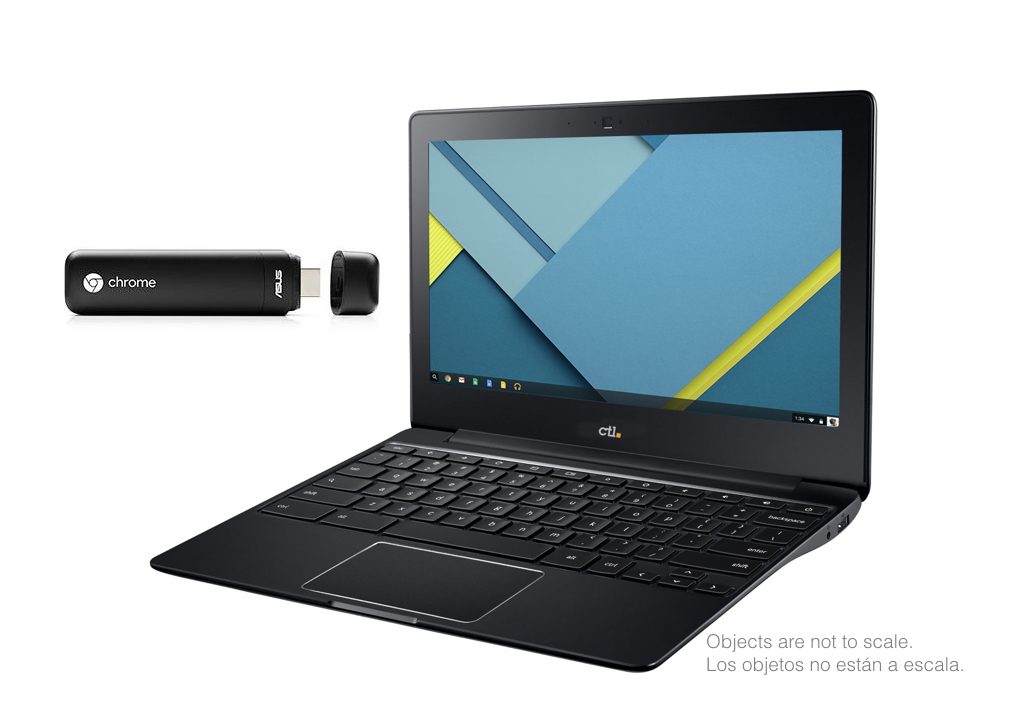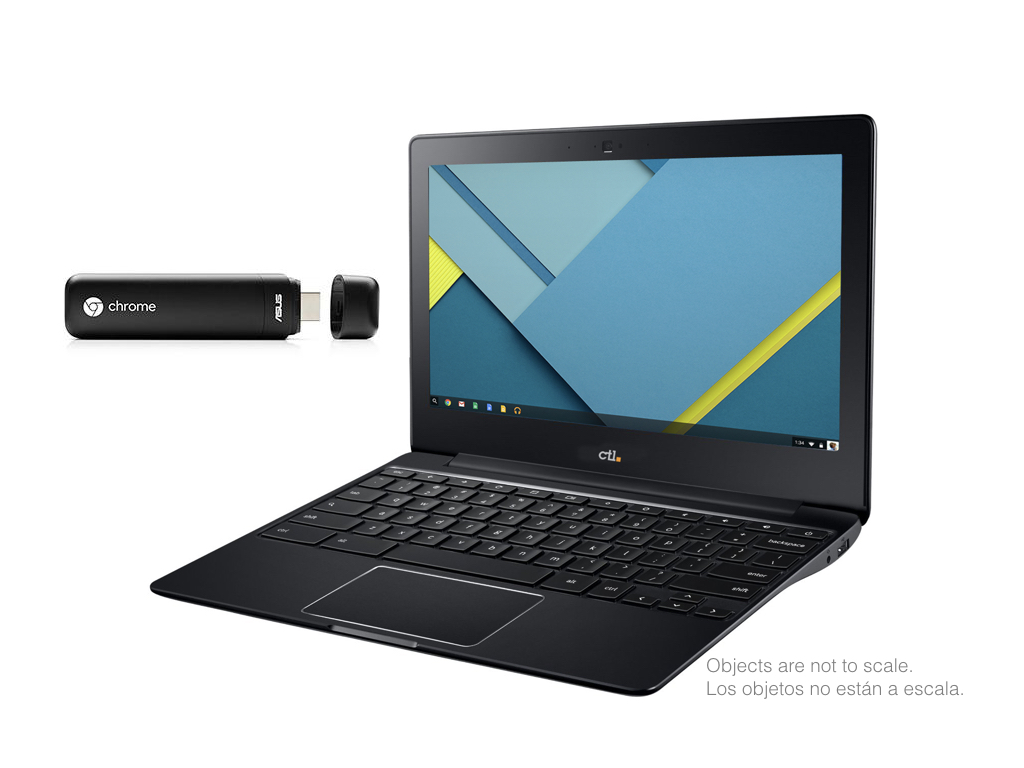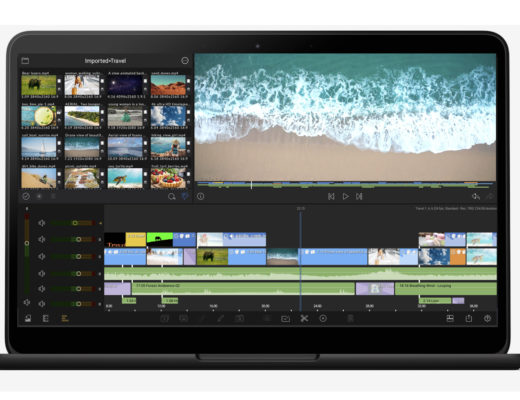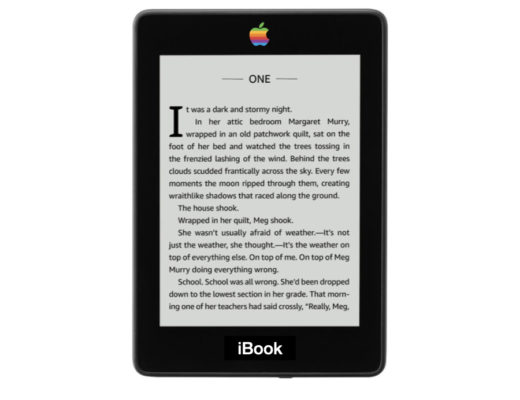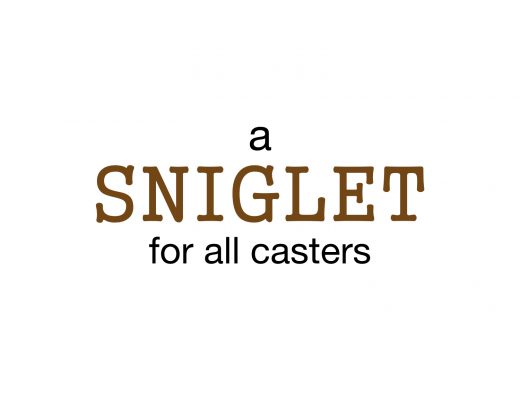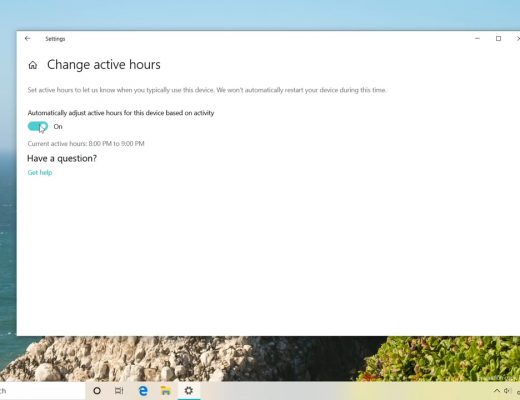In the past few months, I have purchased two quite different Chromebook models, and used them to write, produce and publish two more books. The first is a CTL J4 Plus Chromebook laptop with 11.6” IPS matte screen, 801.11ac dual-band WiFi, HDMI up to 4K UHD and a physical inboard Spanish keyboard, and costs around US$200. The second is a Chromebit stick from Asus, which looks like an elongated USB memory stick, but is really a complete computer that costs well under US$85. You plug the Chromebit into any HDMI monitor, and add your own keyboard and pointer device. Both Chromebooks were more than capable of producing and publishing the two books: Chromebooks for bilingual writers —which is an English adaptation of the original Chromebooks para escritores bilingües which I wrote first. Even though both Chromebooks were quite capable, one is noticeably faster than the other. Ahead I’ll tell you all about my findings about each Chromebook I used, as well as the solar wireless keyboard I used with the Chromebit, and the wireless trackpad.
The two recent short books I wrote, produced and published using Chromebooks
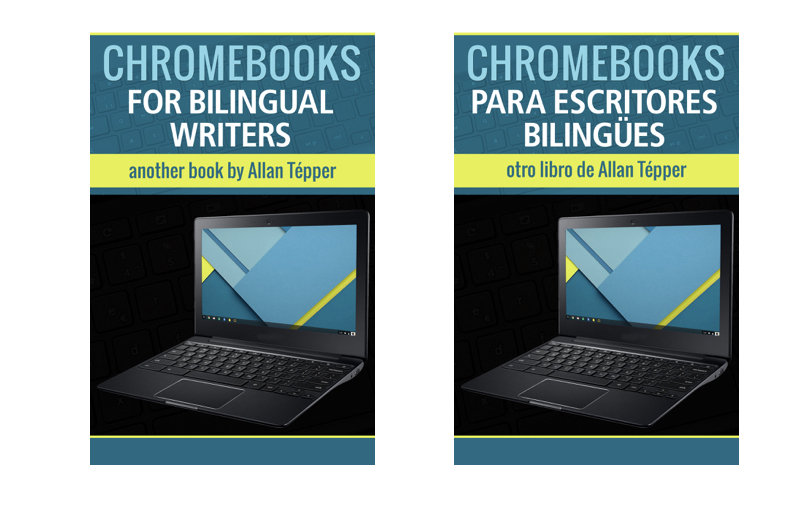
I produced all of my prior books with my MacBook Air. There are the two links to the new books I created completely with Chromebooks are Chromebooks for bilingual writers (in English) and the original version, Chromebooks para escritores bilingües (in Castilian, the most widely used Spanish language). I did about 95% of the writing and production with the CTL J4 Plus, and the other 5% with the Chromebit. However, I have had plenty of use with the Chromebit after finishing the two books. In fact, I wrote this entire article review 100% with the Chromebit.
Myths and realities about Chromebooks
There are many naysayers who incorrectly state that a Chromebook is useless without an Internet connection. In reality, there are many Chrome apps that can work offline, without any continuous Internet connection. A few examples include Google Docs, Stackedit (which I used to write this review article on a Chromebook), a dictionary, the free Kindle Cloud Reader from Amazon, which allows you to read traditional Kindle books on your Chromebook without need of any Internet connection after downloading the books. Of course, you can also read Kindle books without any Internet connection after downloading them to your mobile phone, be it Android, Blackberry, iPhone, Windows… or your Android, iOS (iPad or iPod Touch) or Kindle e-ink or Kindle Fire tablet. Chromebooks have a built-in multimedia player, a photo editor and readers for PDF and Microsoft Office documents that also work offline. What else can you do with a Chromebook besides writing, producing and publishing books? You can:
- Browse the web
- Communicate via email
- Use accounting services like QuickBooks Online
- Receive credit card payments from clients via an online service like Square (Get your first US$1,000 of processing free with that link.)
- Have audible conversations via services like Google Voice, Hangouts and Skype
- Create and mantain a web site or blog, be it with WordPress or Medium.com
- Edit photos and videos (although not at the level of Blackmagic’s DaVinci Resolve, Apple’s Final Cut Pro X, Avid Media Composer or Adobe Premiere Pro CC)
How I discovered CTL, and why I bought my Chromebook laptop from them
CTL is a wonderful US company from Oregon that I didn’t know existed until recently. I discovered CTL on Amazon.es, Amazon’s website for Spain. Even though I am from and live in the United States, I was picking out a Chromebook there because most Chromebook manufacturers refuse to sell their products with a Spanish keyboard in the US, even though Castilian is the second language in this country, and there are more Castilian-speakers in the United States than in Spain. Most of the popular brand names I found at Amazon.es with a Spanish keyboard were older ones that don’t appear on the official list of new Chromebooks that either have the capability of running Android apps, or are about to get that via a free download. CTL was different, since their models were current, and further research helped me determine that company is based in Oregon, and does its manufacturing there. I wrote to CTL’s US sales department to ask whether they would be willing to sell the version of the model CTL J4 Plus with a Spanish keyboard here in the United States, so I wouldn’t have to import it from Spain. The quick and friendly response: “Sure, how many do you want?” was a delight to hear after dealing with so many other computer manufacturers (with the notable exception of Apple) that refuse to sell laptops in the US with a Spanish keyboard. And unlike Apple, CTL fortunately still offers laptops with a matte screen, which is a must if you want to use a laptop outdoors in the daytime. I even prefer a matte screen indoors.

The inboard Spanish keyboard in the CTL J4 Plus Chromebook
What these two Chromebooks have in common
- Both are fortunately on the official Google list of Chromebooks promised to receive Android apps soon via the Google play store.
- Both fortunately have dual-band 802.11ac WiFi.
- Both have Bluetooth 4.0.
- Both fortunately have an HDMI output (although they have different maximum resolutions, as you’ll see ahead).
- Both have 16 GB of inboard storage, which is plenty with tasks typically done with a Chromebook, which also takes advantage of Google Drive for storage. Chromebook purchasers often get 100 GB of free extra space in Google Drive, writable for two years, and readable forever.
- Both are very inexpensive.
Where these two Chromebooks differ
- The CTL J4 Plus is a laptop format, with built-in high quality 11.6” IPS matte screen, and built-in keyboard and trackpad, while the Chromebit has no internal screen, keyboard or pointer. The Chromebit might be called a pocket-sized desktop computer.
- The CTL J4Plus’s HDMI goes up to 4K UHD, while the HDMI on the Chromebit maxes out at 1080p.
- Although both were more than adequate for my needs to produce the two books, the CTL J4 Plus fortunately never made me wait noticeably to load or refresh a web browser tab or play a YouTube video, while the Chromebit occasionally made me wait what seemed to be 2-3 seconds to load the same web pages, especially when both Chromebooks had several browser tabs open simultaneously. I attribute that performance difference partially to the hardware differences: While the CTL J4 Plus has 4GB of RAM, the Chromebit unfortunately only has 2GB, and to my knowledge, it’s not user-upgradable. Very likely, it is also due to the fact that the Chrombit was pushing 2,073,600 pixels to my 1920×1080 27” monitor, while the CTL J4 Plus was only pushing 1,049,088 pixels to its internal 1366×768 IPS display. If a get another CTL, I’ll test it with the 1920×1080 monitor via its HDMI. I did not return the CTL I had purchased: A friend liked it so much that he insisted on buying it from me just as he was leaving for outside of the country and couldn’t wait for another one to be shipped and delivered.
- Both have USB 2.0 (not USB 3.0), although the CTL J4 Plus has two USB ports, while the Chromebit has only one. The CTL J4 Plus also as an MicroSD slot.
- The CTL J4 Plus has built-in stereo speakers, although they are the only feature that is really subpar compared to the rest of device’s quality. However, the CTL J4 Plus does have a TRRS jack (see my article: TS/TRS/TRRS/TRRRS: Combating the misconnection epidemic) to connect analog audio devices, and allows digital ones to be connected via USB or Bluetooth. The Chromebit has no speakers, and depends upon the one(s) built into the connected HDMI monitor, or the one(s) connected via Bluetooth or USB. Chromebooks also work fine with digital audio devices, as I proved with the iRig Mic HD microphone (reviewed here and here).
- The CTL J4 Plus’s inboard keyboard is great. I only missed the illuminated version from my MacBook Air, but I wouldn’t expect CTL or any other manufacturer to include that feature in an approximately US$200 laptop. Ahead in this article, I’ll cover the wireless keyboard and trackpad I used with the Chromebit.
The solar wireless keyboard I used with the Chromebit
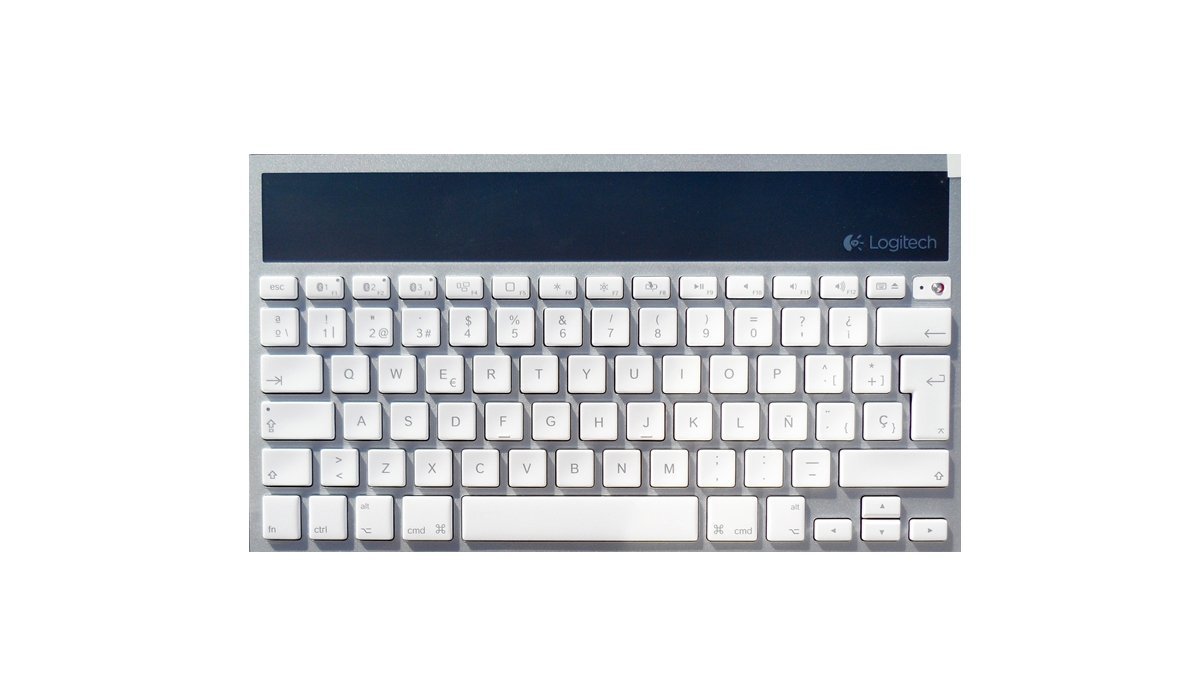
As you’ll see here, my current favorite wireless keyboard is the Logitech model K760. It’s solar and is continually charged by artificial or natural light. After almost a year, I have never had to change the batteries, and in fact, I don’t know whether it’s even possible. Fortunately, it’s available via Amazon (United States) with the Spanish layout you’ll see above. As I have covered in prior articles, are many advantages to the Spanish keyboard even if you type in English. It currently costs under US$20 and is without a doubt the best external keyboard I have ever used to date.
The wireless trackpad I used with the the Chromebit
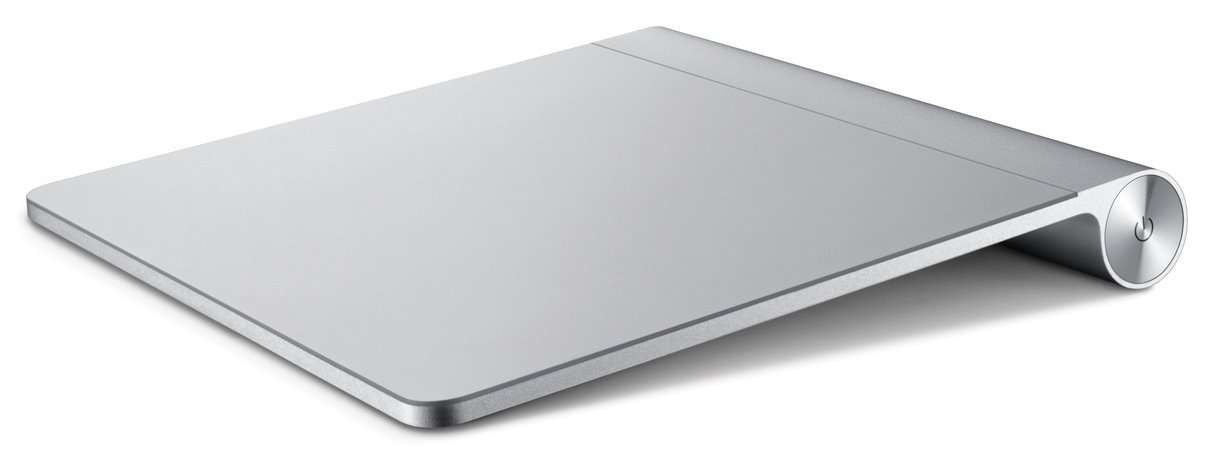
My current favorite external trackpad is the original Apple Magic Trackpad. It’s quite costly, but I got it as a gift from my brother, who received it with his iMac… and he prefers using a mouse. In fact, now the original Magic Trackpad is more expensive than the Magic TrackPad 2 from Apple. They no longer make the original, although sometimes it’s available as refurbished. If I had to buy another trackpad, I would probably try the wireless one from Logitech because it costs so much less, and I have always liked pointing devices from that company. Before using the original Magic Trackpad, I used the Logitech trackball. The reason I migrated from trackball to trackpad is because of the gestures, which saves me time when writing or editing audio or video.
Nit picking on the Chromebit stick
As I write this, the firmware/software on the Chromebit is up to date to versión 55.0.2883.87
plataform 8872.70.0 (Official Build) stable-channel veyron_mickey frmware Google_Veyron_Mickey 6588.197.0. Each time the keyboard reconnects via Bluetooth after the Chromebook waking up from sleep, it takes around 30 seconds before it is usable to type, even though the same keyboard awoke the Chromebit instantly. I blame the Chromebit (not the keyboard) because the same keyboard is available in a fraction of the time when used with my MacBook Air. On the other hand, the Chromebit reconnects almost instantly to the Magic Trackpad. I did not try to connect these wireless devices to the CTL J4 Plus while I had it.
Conclusions
Considering I published those two books and this review, it should be quite obvious that I am very into Chromebooks for the majority of tasks where they work astoundingly well, although I am the first to admit that there are still tasks where a Chromebook doesn’t work yet.
It is astonishing to see that the Chromebook platform is so powerful, even soon for an application like Photoshop. Adobe has already shown and is about to release an authentic Photoshop service for Chromebooks, where Adobe’s service does the heavy lifting, and your Chromebook acts as a remote control and portal to see the result streamed to you in real time. Something similar is already possible with YouTube online video editing, but I know exactly where the limitations lie. I know that online video editing with YouTube doesn’t come close to what is possible with professional tools like Blackmagic’s DaVinci Resolve, Apple’s Final Cut Pro X, Avid’s Media Composer or Adobe’s Premiere Pro CC. I recognize that those services may be sufficient for ENG (Electronic News Gathering), where compressed assets are uploaded and there are few sophisticated transitions or special effects. That’s not the case for commercial TV spots where uncompressed or barely compressed formats like Apple’s ProRes or Avid’s DNxHD. I also know that a Chromebook cannot do the final steps of a multimedia book, as I did with The Royal Spanish Coverup and El encubrimiento de la Real Academia. For the final phase for Kindle multimedia books, you need to use the free Kindle Textbook Creator app from Amazon in a Mac or Windows computer. To do the final steps with Apple’s iBooks platform, you need to use the free iBooks Author app in a Mac. But at least you can write all of the text for those multimedia books on a Chromebook and later perform (or subcontract) that final steps.
There are probably other demanding applications in other fields where a Chromebook won’t be the ideal tool either, but for many people who don’t do such specialized tasks, nowadays Chromebook is an excellent solution. And for those who already have a sophisticated computer at home or at the office for more advanced tasks, perhaps they want a lighter computer with a matte screen to write and do business work outdoors, with daylight.
I wish the Chromebit could be expandable to 4GB, but I am extremely happy with what it does for about US$85. I love the CTL J4 Plus, but wish it had better internal speakers. I hope to review other CTL models in the future, especially one of the ones that promise what has been previously unattainable: the combination of a screen that is matte, touch and color. If you want the CTL J4 with a US keyboard, you can find it on Amazon (US) here. If you want it with Spanish keyboard in the US, you can find it here, directly from their US website. Just be sure to check the option at the bottom of the screen. (You can combine the Spanish keyboard with English-language
menus if preferred.) If you’re in Spain, you can find it here.
Upcoming articles, reviews, radio shows, books and seminars/webinars
Stand by for upcoming articles, reviews, and books. Sign up to my free mailing list by clicking here.
Si deseas suscribirte a mi lista en castellano, visita aquí. Si prefieres, puedes suscribirte a ambas listas (castellano e inglés).
Follow @AllanLTepper on Twitter.
Listen to his CapicúaFM show at CapicúaFM.com in iTunes or Stitcher.
FTC disclosure
No manufacturer is specifically paying Allan Tépper or TecnoTur LLC to write this article or the mentioned books. Some of the other manufacturers listed above have contracted Tépper and/or TecnoTur LLC to carry out consulting and/or translations/localizations/transcreations. Some of the manufacturers listed above have sent Allan Tépper review units. So far, none of the manufacturers listed above is/are sponsors of the TecnoTur programs, although they are welcome to do so, and some are, may be (or may have been) sponsors of ProVideo Coalition magazine. Some links to third parties listed in this article and/or on this web page may indirectly benefit TecnoTur LLC via affiliate programs. Allan Tépper’s opinions are his own.
Copyright and use of this article
The articles contained in the TecnoTur channel in ProVideo Coalition magazine are copyright Allan Tépper/TecnoTur LLC, except where otherwise attributed. Unauthorized use is prohibited without prior approval, except for short quotes which link back to this page, which are encouraged!

Filmtools
Filmmakers go-to destination for pre-production, production & post production equipment!
Shop Now